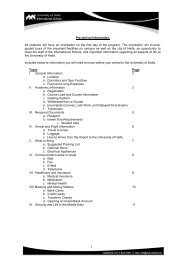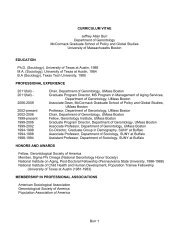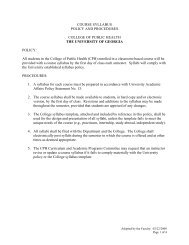Protecting Georgia's Waterways - College of Public Health
Protecting Georgia's Waterways - College of Public Health
Protecting Georgia's Waterways - College of Public Health
Create successful ePaper yourself
Turn your PDF publications into a flip-book with our unique Google optimized e-Paper software.
Epidemiology and Biostatistics<br />
Former English Major Applies<br />
“Replacement Principle” in Battle Against TB<br />
By Johnathan McGinty<br />
“<br />
It may seem somewhat odd that<br />
one <strong>of</strong> the nation’s premier medical researchers<br />
was actually an English major,<br />
but that’s only before you talk to Dr.<br />
Christopher Whalen.<br />
Whalen, a pr<strong>of</strong>essor <strong>of</strong> epidemiology<br />
at the University <strong>of</strong> Georgia’s<br />
<strong>College</strong> <strong>of</strong> <strong>Public</strong> <strong>Health</strong>, wrapped up<br />
his undergraduate studies at Stanford<br />
University with the intention <strong>of</strong> being<br />
a writer. While his interests eventually<br />
shifted to the medical field, principles<br />
he acquired in his English classes still<br />
play a role in his scientific research.<br />
“All along I have been really interested<br />
in critical thinking and research,<br />
and English is actually an exercise in<br />
critical thinking,” Whalen said. “You<br />
read a book or a novel, but your goal<br />
is to try to figure out why things happened<br />
the way they did. So, you ask a<br />
lot <strong>of</strong> questions, you try to look at what<br />
people say and what they do in the context<br />
<strong>of</strong> their writings in order to learn<br />
something about human nature.”<br />
That inquisitive nature has served<br />
him well. Whalen’s work in preventative<br />
care for tuberculosis and HIV/AIDS in<br />
Africa has put him on the front line in<br />
the fight against some <strong>of</strong> the worst epidemiological<br />
diseases in the world. Africa<br />
has been battling accelerating rates <strong>of</strong> tuberculosis for approximately<br />
20 years.<br />
“From a public health and an ethical perspective, you want<br />
to study diseases where they’re at their worst and find solutions<br />
that are relevant for those locations,” Whalen said.<br />
In 2009, Whalen received funding from the National Institute<br />
<strong>of</strong> <strong>Health</strong> to conduct a research and training program with<br />
medical personnel in Uganda.<br />
One <strong>of</strong> his trainees, Dr. Juliet Sekandi, is assisting him<br />
with a study that aims to interrupt the cycle <strong>of</strong> tuberculosis<br />
transmission.<br />
The problem, according to Whalen, is that the diagnosis<br />
<strong>of</strong> tuberculosis <strong>of</strong>ten comes too late.<br />
Individuals may have symptoms for<br />
months before they visit a doctor, and<br />
during that time they may have infected<br />
multiple people.<br />
In the study, Whalen and Sekandi<br />
conducted a cough survey in a targeted<br />
area <strong>of</strong> the Ugandan city <strong>of</strong> Kampala.<br />
Going door-to-door in some instances,<br />
they worked to identify individuals<br />
who had been plagued by a cough for<br />
more than two weeks. Those that met<br />
the criteria were selected for a more<br />
thorough medical evaluation and treatment<br />
if indicated.<br />
Doing so helped them determine<br />
that one percent <strong>of</strong> the population,<br />
a statistically high number from an<br />
epidemiological perspective, had the<br />
disease and were infectious. The high<br />
number <strong>of</strong> positive cases, as well as<br />
their exposure to non-infected individuals,<br />
alarmed Whalen. It has forced<br />
him to re-evaluate the existing paradigm<br />
<strong>of</strong> treatment for tuberculosis.<br />
Currently there are four primary<br />
strategies employed to control tuberculosis.<br />
The first one simply provides<br />
directly observed therapy for individuals<br />
who have developed the disease and are<br />
displaying symptoms. The second approach<br />
focuses on providing a vaccine to populations at risk,<br />
though Whalen noted the vaccine is only effective in children.<br />
Those methods are currently practiced in most developing<br />
countries, such as Uganda.<br />
Another method focuses on treatment <strong>of</strong> latent tuberculosis<br />
infection, which involves providing treatment and medicine<br />
to those who are infected by the bacteria but are not contagious<br />
or showing symptoms . This approach prevents the occurrence<br />
<strong>of</strong> disease later in life.<br />
Lastly, environmental controls, such as negative pressure<br />
rooms that reverse the flow <strong>of</strong> air or use ultraviolent light that<br />
kills bacteria and other pathogens, lessen the spread <strong>of</strong> the disease.<br />
All along I have been really<br />
interested in critical thinking<br />
and research, and English<br />
is actually an excercise in<br />
critical thinking.”<br />
--Dr. Christopher Whalen<br />
Central to Whalen’s philosophy <strong>of</strong><br />
prevention is what he refers to as “the<br />
replacement principle.” While he acknowledged<br />
it was built upon several<br />
complicated mathematical concepts, its<br />
premise is rather simple. Epidemics <strong>of</strong><br />
tuberculosis develop and are sustained<br />
when one infectious case is replaced by<br />
one or more cases among exposed contacts,<br />
at any time in the future.<br />
As they found in the Ugandan<br />
research, one individual exhibiting<br />
symptoms <strong>of</strong> tuberculosis is likely to<br />
come into contact with a large number<br />
<strong>of</strong> other individuals. These contacts<br />
increase the risk that the disease could<br />
be transmitted to another healthy individual.<br />
If one <strong>of</strong> those contacts develops<br />
tuberculosis at any point in their<br />
lifetime, and the original case has either<br />
been cured or killed the infected<br />
individual, the disease has effectively<br />
replaced itself.<br />
“The whole idea <strong>of</strong> this is to block<br />
that replacement,” he said. “If this gives<br />
rise to not one case, but, figuratively<br />
speaking, half a case, and that case gives<br />
rise to another half case and so forth, you<br />
can see that, eventually, you’re going to<br />
bring tuberculosis under control.”<br />
It’s these types <strong>of</strong> concepts that have<br />
Whalen interested in rethinking how<br />
preventative treatment for tuberculosis<br />
is done.<br />
“The next study I’d like to do is one<br />
that takes those four control strategies<br />
and begins to expand them in ways that<br />
address the replacement principle,”<br />
Whalen said. “We could work to try and<br />
prevent that next case from occurring,<br />
but do it in a way that is public health<br />
oriented.”<br />
For instance, he said cough<br />
monitors in public places or pathogen<br />
detectors could provide continuously<br />
updated information that could enable<br />
public health pr<strong>of</strong>essionals to track<br />
potential cases more easily. Better<br />
building codes could include reverse<br />
air flow mechanisms, while active case<br />
findings could identify cases earlier and<br />
prevent transmission in the community.<br />
Whalen said implementing many <strong>of</strong><br />
those components and integrating them<br />
into the existing treatment paradigm<br />
could yield effective results. He would<br />
prefer to do it as a large demonstration<br />
project in a large African city, but it may<br />
be feasible to perform such a project in<br />
a small country such as Botswana.<br />
“If we demonstrate that a multi-dimensional<br />
approach is effective in one<br />
African setting, we may be able to apply<br />
it in other countries in Africa,” Whalen<br />
said. “So that, to me, would be an objective<br />
for the next 5-to-10 years. We<br />
need to get that done and the answers<br />
sooner than later because the epidemic<br />
is not getting better.”<br />
The African continent has been battling increasing rates <strong>of</strong> tuberculosis for the<br />
past 20 years. Dr. Christopher Whalen, a pr<strong>of</strong>essor <strong>of</strong> epidemiology at the <strong>College</strong><br />
<strong>of</strong> <strong>Public</strong> <strong>Health</strong>, has devoted his research to finding more efficient and<br />
effective ways <strong>of</strong> treating - and preventing - the disease.<br />
8 <strong>College</strong> <strong>of</strong> <strong>Public</strong> <strong>Health</strong> Fall 2010 9
















